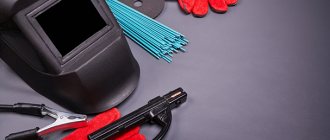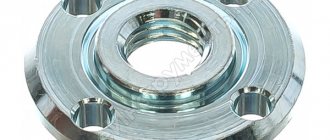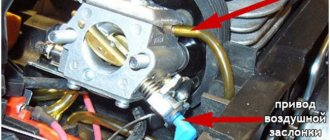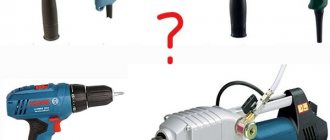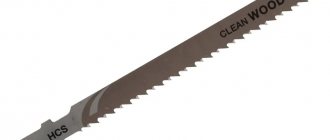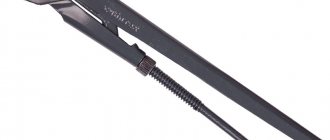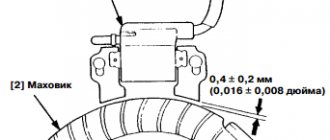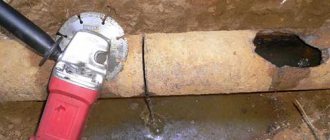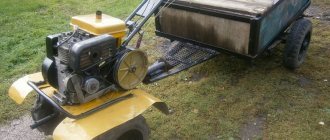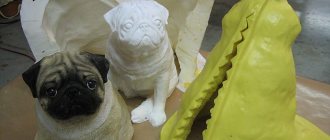A jigsaw is designed for high-quality sawing of various materials, but during its operation you may encounter such a defect as an uneven cut. To avoid this problem, you need to know how to use the tool correctly and what actions to take if it malfunctions.
Almost any jigsaw breakdown can be fixed by yourself
Why can a jigsaw cut crookedly?
Even an experienced worker encounters curved sawing with a jigsaw. This problem is usually attributed to a hardware malfunction. However, most often the reasons are as follows:
- Lack of experience with the tool.
- The blade that needs to be sawed has a defect. You can attach a base of any length to a jigsaw, but if such a problem rarely arises with short-length material, then the curvature of long sticks is present in almost every case.
- Roller failure. There are 2 types: the first is wear of the mounting holes that fix the roller, and the second is abrasion of the inside of the roller.
- A broken rod prevents the tool from working properly.
To identify the reason why the jigsaw is moving to the side, you need to analyze the sequence of actions taken and begin to correct them. Particular importance should also be paid to the speed of movement of the tool.
Important! There is no need to press hard on the device to speed up the sawing process, since the blade will not be able to cut the material at the required speed, and the file itself will go to the side.
To determine and eliminate the cause of a crooked cut, you need to do the following manipulations:
- do not put pressure on the instrument;
- correctly set the speed of movement using the regulator, taking into account the thickness and characteristics of the materials being cut;
- secure the workpiece well;
- Be sure to press the jigsaw firmly against the surface with the sole.
To ensure an even cut, you need to create a support
Straight cutting technique: nuances you need to know
To achieve an even cut, additional tools are used. Before you start sawing, you need to secure the material well. The work surface must be stable. Experts do not recommend sawing wood along the grain. It will be difficult to achieve an even cut. It is better to use a circular saw. If it is not there, you can use a rip fence. One edge is fixed on the product, the second leans against the tool. This way the cut is evened out.
If you need to make a circle, first drill a small hole in the middle. A jigsaw is attached to it, moving along the contours of the marked lines. When a rectangle is required, the saw is pointed forward, rounding the corners and then shaping them.
To make the move easier, use machine oil. They lubricate the file with it. To avoid overheating, you should stop occasionally. After sawing, you need to clean the jigsaw and moisten it with oil.
How wear and quality assembly affect the curvature of the cut
Not all workers know what to do if a jigsaw cuts crookedly, or how to correct such a defect. So, if you purchased a cheap tool, then you should thank the manufacturer for the malfunction.
However, sometimes the fault lies on the shoulders of the employee, since modern manufacturers recommend using inexpensive devices for a maximum of 20-30 minutes per approach. Therefore, if a failure occurs, the fault is most likely in the actions of the owner himself.
The situation is completely different when a defect occurs in professional electrical appliances. In this case, you shouldn’t rush and run to the workshop with the tool; it’s better to figure out why the jigsaw cuts crookedly and carry out the repairs yourself.
Instructions:
- Find out if there is any play in the rod. When its value is more than 0.9 mm, this means that the breakdown lies precisely in its design. Even the best quality guides wear out over time, so it is necessary to monitor their condition.
- The canvas is not tightly fixed. This malfunction is often associated with wear of the fastening mechanism.
- The guide roller is faulty - it does not hold the material and vibrates, as a result of which the jigsaw does not cut smoothly.
- The canvas is deformed. If the shape of the file is curved, then it will no longer be able to cut smoothly.
Important! The reason for a crooked cut may also be due to the dullness of the cutting teeth of the blade, so you need to make sure that they are not worn out, since continuing to work in this case is dangerous to your health.
Often the problem of a crooked cut lies in the curvilinearity of the blade
Repair steps
It is easy to disassemble the tool. The case is divided into two halves, allowing access to all parts of the mechanics. The first step is to remove contaminants and replace the lubricant, after which you can begin repairs.
Replacing stem bushings
Let us note right away that there are no spare parts in stores. You can find the appropriate part by purchasing a broken tool at a flea market. Parts from other devices and mechanisms are often suitable. For example, jigsaws with a round stem exit are the easiest to repair. A round bushing is selected; if necessary, the internal diameter is increased by stuffing it onto a cone. This repair allows you to eliminate runout and play of the rod, and improve the quality of the cut.
If necessary, unique fixing clips are also made (depending on the jigsaw model). When installing them in the housing, copper foil can be used as small pads.
Replacing the rod
In inexpensive jigsaw models, the rod is a thin metal plate of complex shape. If overloaded, it may simply burst. The part is replaceable, some jigsaw models are compatible with others. The device must be carefully disassembled, recording the process in the photo, in order to reassemble it. Then, with the part removed, go to the market or store. Then install the part and apply lubricant.
Replacing brushes
Most jigsaw models, unless we are talking about frankly budget ones, come with a pair of pullers
. To replace them, just open the housing: in the rear of the engine, on the contact block, the necessary elements are immediately visible. Repair is simple: old parts are carefully removed, contact pads are cleaned of dust, and wiped with alcohol. After this, it is enough to install new brushes.
Replacing the start button with speed control
You can purchase a replacement part both at specialized points and in stores that sell spare parts for electronic devices. The jigsaw body opens and the corresponding part is freed from the wire leads. This often needs to be done after unscrewing the terminal screws. Modern models do not force you to use a soldering iron. After removing the old one, the new part is installed and connected.
A fairly rare failure is the failure of the engine thermal fuse. The part is being replaced. Sparking may be observed, which indicates not only a heavy load, but also wear on the brushes and lack of lubrication. Therefore, periodic maintenance is the key to reliable operation of the jigsaw.
Checking the installation of the sole relative to the file
Already when purchasing a device, for example, the Interskol brand, you may encounter incorrect installation of the vertical angle. To correct such an error, you need to loosen the fasteners yourself, move the sole, install it and then firmly fix it.
The flatness of the sole must also be checked. If this condition is not met, you need to remove it from the tool and straighten it using a bronze hammer on an anvil. The final step will be sanding the surface with sandpaper.
Each time it is necessary to check the device for malfunctions.
Rules for working with a jigsaw so that the tool does not move to the side
To prevent the process from leading to various problematic situations, it is recommended to adhere to the following recommendations from experts:
- Secure the workpiece on the workbench. If you do not do this, the part will vibrate, which will lead to uneven cuts.
- Wood along the grain is difficult to cut straight. To carry out the process, use a special stop or take a circular saw.
- If it is necessary to cut a circle inside the part, you need to drill a small hole. Then insert the tool into it and cut according to the planned plan.
- To prevent the cutting line from bending in one direction or another, you should not press excessively on the tool when working. If the equipment is difficult to operate, lubricate it with machine oil, which will also have a beneficial effect on facilitating the work process and extending the life of the equipment.
- Sharpen the file regularly so that the workpiece does not have torn edges.
When working with tools at low speeds, it is recommended to stop after 15 minutes, as the process has a negative impact on the engine. It may overheat and fail.
Observe safety precautions when working. Wear safety glasses and gloves when working with the tool. When you finish working, you need to thoroughly clean the equipment and lubricate it.
How to quickly learn to cut smoothly with a jigsaw
The process of sawing materials consists of many important stages, so:
- The blade of the required length, thickness and width is selected. Then its relationship with the workpiece material is checked.
- Preparing the work progress. It is important to determine the need for a pendulum stroke.
- Installation of additional equipment when necessary.
- Preparation of the workplace. You will definitely need a strong and most importantly stable stand, preferably with a flat surface.
- The cutting line is determined. For convenience, it is best to use a black marker, of course, if you can leave marks on the material. Otherwise, you should use a simple pencil, traces of which can be easily removed with an eraser.
- The workpiece is fixed on a stand. If the part does not completely fit on the surface, you need to install a support under it, otherwise the jigsaw will lead.
Wood is the most popular material for cutting.
Since the cutting process varies depending on the type of surface, it is important to understand how to properly cut different materials:
Tree
When cutting this material, special attention is paid to the choice of file. You need to choose standard nozzles, with an average tooth size and a pitch interval of 0.25 to 0.4 cm.
The cleanliness of the move must be set to the maximum level. As for the work itself, you should start sawing carefully, controlling the progress of its actions without haste, without pushing the device.
Attention! To increase cutting speed, use a function called “pendulum stroke”.
Metal
To cut metal, you need to choose files with small teeth, the pitch of which is in the range from 0.1 to 0.15 cm. A prerequisite is to turn off the “pendulum” and set the stroke rate to the lowest level.
During operation, you cannot press the device; it needs to smoothly saw through the metal.
Important! To prevent the metal from heating up, it is necessary to take short breaks so that it has time to cool.
Plastic
For plastic, you need to choose a file with small teeth to improve the quality of work. The jigsaw should be adjusted based on the type of plastic being cut. In order for the cut to be smooth, the device must be set to the minimum value with the pendulum stroke obligatory turned off.
Choosing the right tool
Experienced experts advise purchasing a household or semi-professional D-shaped jigsaw. Operating the device is simple. Powerful models weigh more, so cutting them is difficult.
To ensure that the work does not pose a problem, you should select models equipped with a step speed controller, an electronic stabilizer and a pendulum stroke. The canvas is securely attached if you take a special plastic cover. When choosing a tool, it is recommended to consult with specialists and read the instructions. It describes the advantages of working with one or another version of a technical device.
DIY jigsaw guide
If a jigsaw cuts at an angle, how to correct the situation? It should be understood that a high-quality tool can efficiently cut any material. If the tool cuts crookedly, then you should make a guide for it yourself.
The principle is as follows:
- Take a straight batten made of fiberboard or chipboard with a thickness of at least 5 mm, a level or a steel profile.
- To secure the rail you will need clamps or screws.
- That's all, the guide is ready, all that remains is to adjust and test it in practice.
Important! To start using a homemade workpiece, you need to draw a cutting line and make markings parallel to it at an equal distance from the original one.
You can make a high-quality tool guide yourself
Several reasons for problems during operation
There may be several reasons why the jigsaw moves from side to side:
- Lack of proper qualifications of the employee.
- The master did not fasten the workpiece tightly enough.
- The tool is faulty. To correct the situation, inspect the device and fix the breakdown.
- Do not put too much pressure on the device, as pressure can also lead to problems.
Recommendations and rules for cutting smoothly with a jigsaw
To learn how to cut smoothly with a jigsaw, you should follow a number of recommendations:
- Select blades for the material, taking into account their thickness.
- Before starting work, the workpiece must be firmly secured.
- Mark using a marker or pencil.
- Each time the tool must be checked and all faults eliminated.
- Be sure to use guides.
- Use a vacuum cleaner that will clean the surface and leave the marking line visible.
- 7. Do not push the tool.
To improve the quality of sawing, you should make markings.
Almost any defect in the operation of a jigsaw can be corrected; you just need to correctly identify the cause and make every effort to eliminate it.
Prevention of breakdowns
Preventative measures always extend the life of any tool, including jigsaws. To begin work, unscrew the screws and open the housing. Using alcohol and a cotton cloth, it is necessary to clean all components from old grease. Then new lubricant is applied to the required points (in accordance with the recommendations specified in the instruction manual)
It is very important to process the dynamic parts of the unit (current, gearbox)
There are also a number of preventive measures:
- use only “original” parts;
- produce fabrics by 70 percent and then change them;
- use only those canvases that correspond to the nature of the work;
- during work, you should not “strain” yourself with excessive mechanical loads;
- Clean the instrument from accumulated dust at least once a week;
- use WD-40 lubricant;
- use a vacuum cleaner for cleaning;
- do not hit or drop the tool - this often leads to damage to the supporting rod;
- Do not tighten the file in the mount too much;
- for materials that are too dense, there are special devices that must be used;
- each material has its own optimal operating mode (speed, angle of inclination, etc.);
- the base of the support roller must be treated with a special technical lubricant at least once a week;
- You should actively use technical brushes to process the tool after finishing work;
- You should always monitor the ventilation grille of the instrument and clean it of mechanical microparticles.
You will learn how to repair a jigsaw with your own hands from the video below.
How to make a perfect cut with a jigsaw
To get a correct, beautiful and straight cut, you need to follow the following recommendations.
Selection of cutting blade
For shaped and fine work, it is better to take thin files . If you need to make a complex pattern, you need to use files with 2 cutting edges . The leading edge guides the main cut, and the rear edge makes the saw maneuverable, preventing scraps.
Fastening material
Many people neglect such a simple rule as fastening the material. It's one thing when the structure itself is bulky . There is no need to pin anything here. But if you need to cut, for example, a sheet of plywood, you can’t do without fasteners. The material is light and without fixation you can ruin everything.
The advantage of sawing logs with a chainsaw
Cutting into boards can be done using tools such as an electric chainsaw and additional accessories designed to simplify the work. When choosing certain products, you need to focus on the amount of work expected. Stationary sawmills are expensive and are purchased only if you plan to organize a business to create boards.
The most accessible tool for the job is a chainsaw. Such devices have several advantages over electric ones:
- the chainsaw can be used anywhere, regardless of the availability of an electrical outlet;
- the tool is suitable for working in conditions of high humidity;
- professional chainsaws are significantly more powerful than electric ones;
- You can use the chainsaw continuously for an hour.
To cut logs into boards, a special frame is used together with a chainsaw, which is attached to the device and allows you to create boards of the same thickness. A device is also needed to secure the log in one position. In addition, you will also need a guide.
Since household gasoline saws are not designed for heavy loads, it is worth using professional tools for sawing logs
When choosing, you should pay attention to devices with a power of more than 7 horsepower. Before work, the fixed frame is adjusted in accordance with the selected width of the boards
To create a frame, you can use legs from a school desk or metal corners.
Lightweight nozzle
Such devices are often used, but they should only be used when creating boards for fences or sheds. This is due to the fact that the attachment is secured to the tire only on one side.
Useful information
Application of adhesive tape
The fact that we cut smoothly with a jigsaw does not always give the desired result. Adhesive tape, for example, even ordinary tape, protects the back side of the material. Tape should be glued to the cut line, which will protect the processed fabric from tearing off large elements. Masking tape cannot be considered a sufficiently effective option for preserving material when cutting with an electric jigsaw, because the strength indicator is very low. It is best to use a fairly wide reinforced or aluminum fiberglass tape (each side of the cut on the material should be covered by at least 15 cm). Moreover, the adhesive tape should be pressed with a dry cloth to eliminate the risk of wrinkles.
Reworking the jigsaw sole
When setting up an electric jigsaw, you first need to check that the blade is perpendicular, because sometimes it is not easy to fix the clamp. Experts often modify the sole of the tool, namely, reduce the gap between the pressure pad and the leg. This will help eliminate “breakage” of the crust in the layers of material on top.
Please note that when using overlays, every novice craftsman must remember that they should not scratch the surface of the part. In this case, they should be replaced every 5 meters of cutting.
Zero clearance can be obtained by attaching the cover plate to the support leg of an electric jigsaw.
Making a clean cut
In most cases of material processing, the chip size is reduced to 0.5 mm. Such minor imperfections are practically not noticeable, and they can be removed by chamfering with sandpaper or covering up the chips with a correction pencil. You can also sand the end with sandpaper or cut through the top of the surface with a utility knife. To begin, you will need to make two cuts with a depth of 0.5 mm on both sides of the part, and also indicate the thickness. Mark two grooves along the edges of the cut, which can be made using an oblique segment or shoe knife (for uncoated wood material, or for chipboard), or using a pobedite cutter and a sharp blade (for laminate).
Correcting existing chips
Cutting material with an electric jigsaw and avoiding chipping is an almost impossible task. You can do this - cut the part with an electric jigsaw with a small allowance (about 0.2 cm), and then mill or grind off the allowance with a belt sander. During milling, the edge is cleaner than when working with a grinder. As a rule, material is milled on a tire that is made by hand (modeled on a tire from a circular saw). Spiral cutters help improve the quality of milling, and you should prepare them (two pieces).
If you want only the front side to be clean, then you need to use the simplest two-flute cutter. If both clean sides are required, use a four-flute router bit with two main flaps running to the left and two scoring flaps running to the right. In this case, it will turn out that when cutting the material, the upper branches will press the material down, and the lower ones will pull it up. This will prevent the formation of chips on the edge.
Some features of the process
Initially, you need to choose the right jigsaw file. The variety of files allows you to choose the option that will correspond to both the material of the original workpiece and the final desired result.
In general, a jigsaw can be either pendulum or conventional. In the second option, for an even cut, the blade must be moved clearly vertically, cutting the material upward. Due to the high speed generated, the blade wears out more slowly.
When working with a pendulum tool, the principle is essentially the same, only the preferred material for processing is soft wood or plastic; difficulties may arise with steel.
In order to make a straight cut, you need to choose a wide blade; it is better if the jigsaw has a “Smooth start” function, which will allow you to avoid sudden movements at the initial stage. If you need to cut a round hole, you first need to drill the original version, into which the necessary file is inserted. The cutting itself is carried out according to the markings. If the original version cannot be cut, then a plunge-cut method is required. To do this, the jigsaw is tilted at an angle until it comes into contact with the material, this allows you to make a through hole, after which you can do what is necessary according to the markings.
If you need frequent circular sawing, it is advisable to purchase an additional device called a circular cutter.
It is allowed to cut along the edge of the workpiece, but you must make sure that it is initially even, otherwise the jigsaw will cut crookedly. If the edge is uneven, then only correct marking can correct this.
When working with thin wooden sheets, there is a risk of chipping. To prevent this, the sheet should be placed face down.
For even sawing of panels, there are special devices, so-called machines. They can be vertical or horizontal.
The names speak for themselves. In the first case, the panels are installed vertically, the beam mounted on the guides acts as a bracket. The ability to rotate it to a right angle allows you to saw off material in any plane. The horizontal version requires the presence of a table for sawing, the mechanism itself and a carriage that ensures the movement of the file along.
Jigsaw Fiolent: main reasons for failure
Replacing the rod
In the first case, to avoid this damage, it is enough to handle the tool carefully and carefully. But if this happens, you will have to replace the damaged rod. To do this you need:
- Remove the housing cover by unscrewing the 4 screws.
- Remove the rectangular washers and retaining guides from the rod.
- Unscrew the 4 bolts and remove the mechanism cover. Below it is the flywheel and the rod itself.
- Unscrew 2 screws each, remove the lower and upper rod holders. The latter has a spring, so you need to remove it carefully.
- Remove the damaged rod with guide washers.
- Lubricate the flywheel and eccentric with special gearbox lubricant.
- Place the guide washers on the new rod and install it in place.
- Attach the saw blade holder to the lower part of the rod.
- Install the upper and lower holders, screw on the mechanism cover and install washers and retaining guides.
- Insert the cutting tool and test the jigsaw at idle and under load. If the check does not reveal any deviations, install the housing cover.
Tool lubrication
In the second case, everything is much more serious. It would seem that what is so difficult about lubrication? But due to the fact that the tool constantly operates in extreme conditions, wood dust cannot be avoided getting inside the device; service work has to be carried out according to the intensity of use, but at least once a year.
All mating parts and assemblies need to be lubricated. To do this, you need to disassemble the jigsaw. But if in the first case you, for example, limited yourself to only dismantling the rod, now we disassemble the tool completely and smear all the rubbing surfaces of the parts.
For lubrication, the manufacturer offers Litol 24, but it will not work in a jigsaw gearbox due to its thick consistency, so it is usually lubricated with oils. You can combine Litol 24 with graphite-containing lubricant Feol 2U in a ratio of 3:1.
What to do if you have problems with accuracy
- The main requirement is reliable fastening of the material for which processing is required. In addition, cutting should be convenient for the person himself.
- It is better to use guides if there are serious doubts that a person will cope with the work. For example, a block of wood will be an excellent guide for straight cuts. It is simply secured along the markings. It is much more difficult when the shape of the future product is quite complex. Then the use of patterns is recommended. Otherwise, the speed of work will have to be reduced so that the result is more accurate.
- Problems with the saw are one of the most common problems during cutting. There is a possibility of chipping and dullness. It is better to inspect it if it is noticeable that the instrument is moving strongly to the side.
- If there are jerks, there is a possibility that the cut will move to the side. Other failures in the instrument also lead to a decrease in accuracy. It is recommended to begin eliminating such problems immediately, on the spot.
- The skill of the performer himself also affects the accuracy of the final work.
Blade holder faults
Many modern jigsaws are equipped with bells and whistles, which are their weak points. For example, some models often require repair of the saw blade mount due to the presence of such functions as:
- A quick clamp
that does everything for the tool owner: just move the lever, place the blade and work. Over time, the structure becomes loose and fastening parts become unusable. Unfortunately, most of these clamps cannot be repaired; they must be completely replaced. - Lightweight screw fastening
is a real problem for owners of cheap and mid-price tools. The rod attachment, made of weak alloys, has low strength, breaks, and the bolts break the seats. Repair consists only in the handicraft production of the appropriate product from durable steel, since each line of cheap tools often has its own saw blade holder configuration.
If the jigsaw has a classic screw fastening of the file, then repairing it will not be difficult. This is a durable and time-tested design; you can use bolts for a Phillips screwdriver or a wrench. The clamping blocks are standard; finding a replacement for an extremely worn part is not difficult. There is a problem with thread wear, but in this case a new one can be cut.
Professional secrets
Cutting with a jigsaw according to the drawing
It is necessary to check how firmly the canvas is fastened.
This mechanism may have its own characteristics depending on the manufacturer.
It is recommended to ensure the reliability of the fastening before starting work.
To work with any cutting tools, the fastening of the blade, its general position, is really important. It is best to read the instructions that come with the kit in advance.
It is best to read the instructions that come with the kit in advance.
A useful device would be a system responsible for removing sawdust. Its operating principle is very simple. There is a flow of air from the fan cooling the motor.
It is used to remove debris. The removal system makes the cut line more visible to the master's eye.
The drill can be easily changed when cutting holes using a technique called "pocketing". To do this, just tilt the jigsaw forward, then the rounded tips will rest on the surface being cut.
The blade should be positioned above the future cutting line with maximum accuracy. You need to lower the support saw horizontally and then continue cutting.
First stage
First you need to prepare the necessary tools:
- clamps;
- pencil;
- bar or beam for guide;
- jigsaw;
- measuring tool.
When starting work, you should secure the workpiece as firmly as possible. It is not at all advisable to use a jigsaw to cut along the fiber, because in this case it will not be possible to cut straightly. But if such a need still exists, then you can use a parallel stop, one end of which is attached to the jigsaw, and the second rests against the edge of the workpiece material. In this way it will be possible to saw off extremely smoothly.
If you need to cut with a jigsaw in the inside of the workpiece, you should first drill a hole in it. After this, a saw blade is inserted into the drilled hole, and the jigsaw is moved exactly along the marking line. Once the cut is complete, adjust the corners on each side of the workpiece.
Sawing should be done using a guide, which can be a straight bar or block. You will need several clamps into which the workpiece material and guide should be placed. Cut smoothly with a jigsaw
It is necessary to place something under the workpiece so as not to rest when working with a jigsaw. Next, using a measuring tool, measure the width of the area that needs to be cut.
Then a line is drawn along the ruler connecting the marks. After this, the guide is secured with clamps at the required distance from the edge of the cutting line.
Then the jigsaw is placed with the blade against the cutting line. The guide is pressed against it and also secured with a clamp.
You need to fix it motionless, but you shouldn’t clamp it too hard. Next, everything is done in the same form on the opposite side.
So, the measures necessary to make the cut smoothly have been taken.
Next, after turning on the jigsaw, you need to set the speed to the maximum and adjust the movement of the pendulum, setting it to one. The jigsaw is placed with the blade against the cutting line, the platform is pressed sideways against the guide, and you can start sawing.
Second phase
When working with a jigsaw, you should avoid applying excessive pressure on the tool. The device is pushed forward with a slight movement, also exercising control over the platform.
The edge of the sole should be pressed against the guide so that it does not move. At the end of the cut, when a couple of centimeters remain to the edge, it is necessary to hold the sawn fragment to avoid breaking.
In order to achieve higher cutting accuracy when working with a jigsaw, and to cut small parts more evenly, an auxiliary method is the use of a sawing table. It is attached to the main work table using a clamp. The cutting process on this table is done in reverse. In this case, you have to move not the jigsaw, but the part itself. As a result of this cutting, the lines come out more evenly. How to cut smoothly with a jigsaw?
To improve the quality of movement of the saw on the workpiece, you can use an auxiliary device in the form of a replaceable plate, which can be made of various materials. The plate is attached to the main support platform of the jigsaw. The adapter and guide bar allow you to cut more evenly.
When cutting some materials with a jigsaw, there is a need to cool them. Therefore, before you start cutting, you need to install a container with cold liquid on the support platform, designed specifically for this.
If you have at least once tried to cut chipboard at home, then you know for sure that this work is by no means easy and requires not only skill, but also the availability of a good tool. Laminated chipboard is especially difficult to process; when cutting it, many chips often form. That is why many craftsmen, faced with such a problem, come to the conclusion that it is better to cut chipboard when purchasing, especially since many trading organizations provide similar services and the price is quite reasonable.
Chipboard sawing is carried out using precise format-cutting machines, which will help obtain workpieces of a given size and shape.
In addition to cutting sheets, they will help you calculate and provide in the form of a visual video file several options for competent and economical cutting of sheet material (using special computer programs) and, if necessary, perform edging. However, if for some reason you prefer to do this work yourself, you will have to do some preparatory work before cutting the chipboard.

